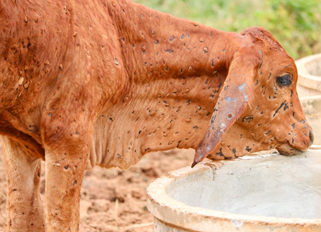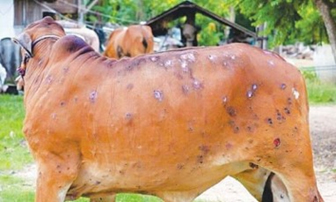Lumpy skin disease – information for veterinarians
This information is also available as PDF fact sheet: Download Lumpy Skin Disease - information for veterinarians (PDF - 218.1 KB)
Lumpy skin disease is caused by a Capripoxvirus that affects cattle and buffalo. The disease has never been recorded in Australia, but internationally it is spreading rapidly.
The heightened risk of an incursion in Australia
Although lumpy skin disease is not present in Australia, its recent detection in Indonesia and ongoing spread throughout neighboring Asian countries is very concerning.
Lumpy skin disease would be costly and challenging to control or eradicate should it reach Australia, with wide-ranging and significant long-term impacts for our livestock industries.
Like Japanese encephalitis and other vector-borne diseases, unless an incursion is detected early, its eradication or elimination (eradication in a defined geographical area) would be difficult.
Australia’s current response policy for lumpy skin disease is to eradicate it in the shortest possible time, by the destruction of infected animals and contaminated products, quarantine and movement controls, insect vector control and other activities.
A vaccine is not currently available (or its use permitted) in Australia, although vaccines are in use internationally with varying success in terms of disease control.
The economic impact of an incursion in Australia would be considerable due to the disruption of trade in livestock and livestock products (including products from sheep and goats, not just cattle), as well as costs associated with disease control and eradication.
Continued vigilance is essential in order to detect an incursion as quickly as possible, and thereby protecting the health of the Australian cattle herd, as well as Australia’s export trade in livestock and livestock products.
 Clinical signs
Clinical signs
Clinically, disease may range between subclinical disease to severe illness or death.
Initial clinical signs may include fever (40-41.5 0C), depression, anorexia, and reluctance to move. Rhinitis, conjunctivitis and excess salivation may also be apparent.
Cattle may develop large, firm nodules (up to 5 cm in diameter) in the skin. These can be found over the entire animal, but are found particularly on the head, neck, udder, scrotum and perineum. The nodules may become necrotic and ulcerate, leading to an increased risk of secondary bacterial infections and flystrike. In severe cases, the nodules can fall away leaving full-skin thickness holes in the animals hide.
Affected bulls may not work due to painful lesions on their prepuce, and cows may abort or become anestrus. Live neonates or aborted fetuses from infected cows may also present with skin lesions.
In severely affected animals, lesions can also develop in the respiratory and gastrointestinal tract. Pneumonia is a common, and often fatal, complication.
Bos taurus cattle are generally more susceptible than Bos indicus cattle. Jersey, Guernsey, Friesian and Ayrshire breeds are particularly susceptible.
Morbidity rates vary greatly, ranging between 1-95%. Mortality rates are usually 1-5%, but have been reported as high as 75%.
Disease transmission
Lumpy skin disease virus is spread primarily by biting insects such as flies and mosquitoes, and possibly ticks. It can also be transmitted by fomites, and in some cases, from animal to animal.
The virus is present in high concentrations in the skin nodules and scabs on affected animals, and can be isolated from blood, saliva, ocular and nasal discharges and semen.
Virus can be found in blood for up to 21 days post-infection. Shedding in semen may continue for at least 42 days post-infection.
Lumpy Skin Disease is not Zoonotic
The virus is highly host specific and does not cause disease in humans.
There is no risk from consuming beef or dairy products.
Differential diagnoses
Differential diagnoses include:
- urticaria
- pseudo lumpy skin disease (bovineherpes mammalitis; herpesvirus 2)
- bovine papular stomatitis (parapoxvirus)
- dermatophytosis (Trichophyton spp., Microsporum spp.)
- pseudo cowpox (parapoxvirus)
- vaccinia virus and cowpox virus (orthopoxviruses)
- streptothricosis (Dermatophilus congolensis)
- demodicosis (Demodex bovis)
- insect or tick bites
- onchocercosis (Onchocerca spp.)
- besnoitiosis (Besnotia besnoiti)
- cutaneous actinobacillosis (Actinobacillus lignieresi)
- rinderpest
- Hypoderma bovis infection
- photosensitization
- skin tuberculosis.
Suspicion of Lumpy Skin Disease
Lumpy skin disease is a notifiable disease. All suspected cases must be reported to Agriculture Victoria on the Emergency Animal Disease Hotline on 1800 675 888 or to local Agriculture Victoria Animal Health and Welfare staff immediately.

Sample collection
Diagnosis of lumpy skin disease is based primarily on detection of the virus in lesions. Detection of antibody in serum may also aid diagnosis.
Specimens that should be collected from live animals include:
- blood (from animals with fever)
- serum
- nodular fluid
- skin biopsies of suggestive lesions
- scabs, and
- skin scrapings from lesions.
At necropsy, a range of samples, both fresh and fixed, should be taken from skin lesions, lesions in the respiratory and gastrointestinal tracts, and other internal organs.
Following the initial diagnosis of lumpy skin disease, a more restricted sample set, still based on sampling lesions, may be defined.
Return to the Lumpy Skin Disease main page.
